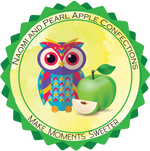Native American Heritage Month
November is a season of gratitude — not just for abundance, but for understanding where that abundance began. During Native American Heritage Month, we at Naomi & Pearl Apple Confections pause to honor the first farmers, foragers, and food artisans of North America — Indigenous peoples whose traditions and ingredients still shape how we cook and bake today.
The First Ingredients of Home
Long before wheat, sugar, or butter arrived on these shores, Indigenous communities were cooking with what the land offered: corn, beans, squash, nuts, maple, berries, and wild rice. These were the foundation of nourishment, celebration, and community.
-
Corn (maize) — cultivated over 7,000 years ago and ground into meal for breads and cakes long before ovens existed.
-
Maple syrup — tapped and boiled by Native peoples of the Northeast, it was North America’s first natural sweetener.
-
Pumpkins, pecans, cranberries, and beans — each a gift from Indigenous agriculture that continues to flavor today’s autumn desserts.
These foods carried a philosophy as much as a flavor: food is relationship, not possession. Every harvest was a reminder that what the earth gives must be shared with care.
Thanksgiving, Seen Through Two Lenses
For many Americans, Thanksgiving means gathering in gratitude. For many Native peoples, it also carries grief — a Day of Mourning, honoring ancestors lost to colonization and displacement. Both truths can exist together.
Across Native communities, many still celebrate gratitude and harvest on their own terms, using traditional foods like wild rice, venison, corn, and berries. These meals affirm endurance, memory, and the living heartbeat of culture.
Recognizing this fuller story doesn’t diminish the holiday — it deepens it. Gratitude grows stronger when we understand who first tended the soil beneath our table.
A Modern Voice: Chef Sean Sherman (Oglala Lakota)
Chef Sean Sherman — known as The Sioux Chef — has devoted his career to reviving Indigenous foodways. Through his restaurant Owamni in Minneapolis and his nonprofit NATIFS (North American Traditional Indigenous Food Systems), he teaches that food sovereignty and cultural restoration begin with what’s on our plates.
One of his signature dishes, the Three Sisters Mash, celebrates the agricultural system of corn, beans, and squash — crops that thrive together and nourish communities. This dish represents balance and interdependence, reflecting the same respect for the earth that defines Indigenous cuisine.
While we can’t reprint Chef Sherman’s full recipe here, you can explore his work and more Indigenous creations at www.sioux-chef.com or in his James Beard Award-winning book The Sioux Chef’s Indigenous Kitchen.
About Chef Sean Sherman
Chef Sean Sherman (Oglala Lakota) is an award-winning chef, author, and educator recognized internationally for revitalizing Native American cuisine. His work through NATIFS focuses on food sovereignty, Indigenous entrepreneurship, and reconnecting communities with ancestral ingredients.
“Indigenous foods are not a trend — they are the original cuisine of this continent.” — Sean Sherman
At Naomi & Pearl Apple Confections, every cookie tells a story of gratitude — for the land, the people, and the traditions that made sweetness possible.
#NativeAmericanHeritageMonth #NaomiAndPearl #ChefSeanSherman #IndigenousCuisine #BakedWithGratitude #HonoringTradition
